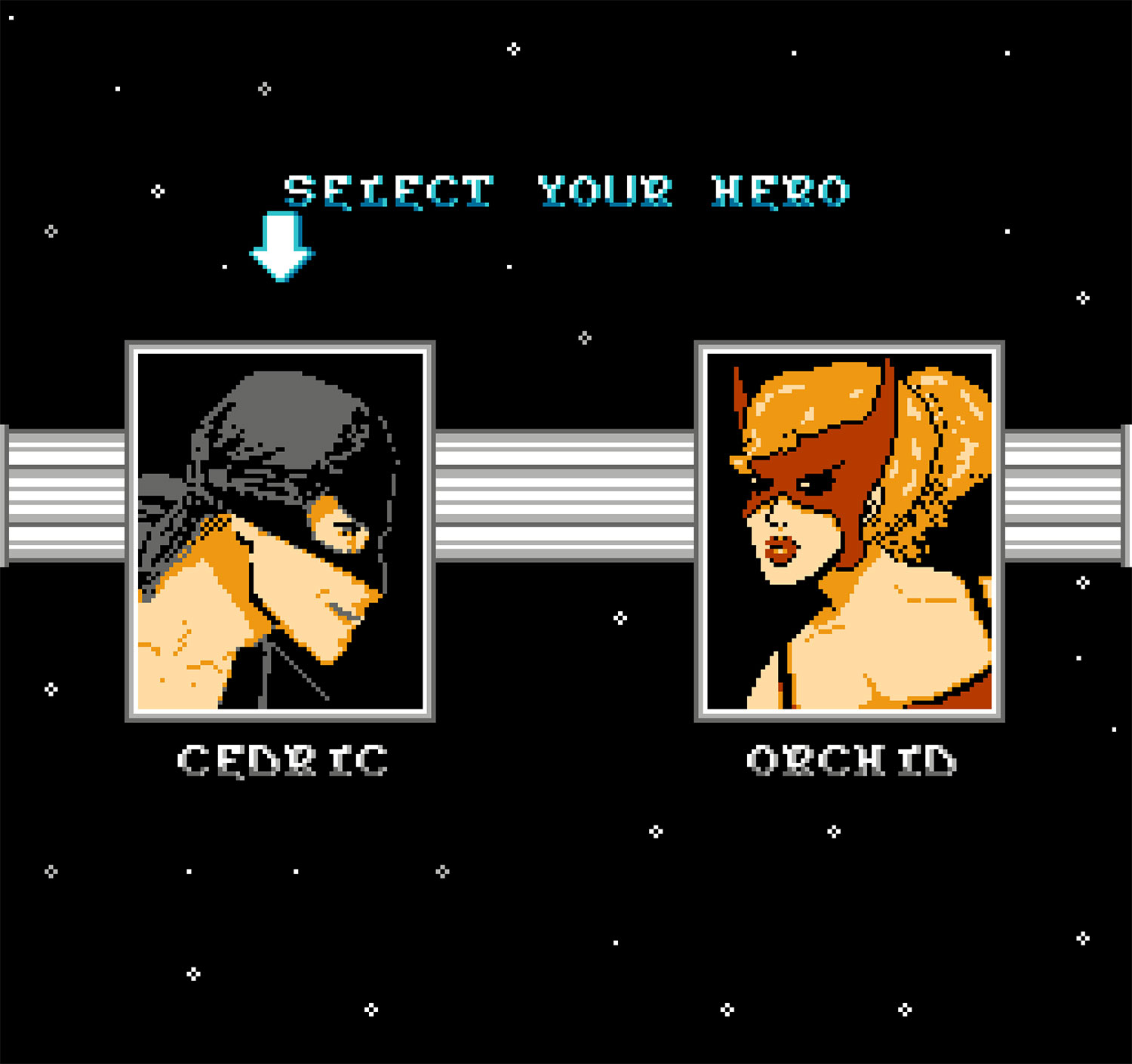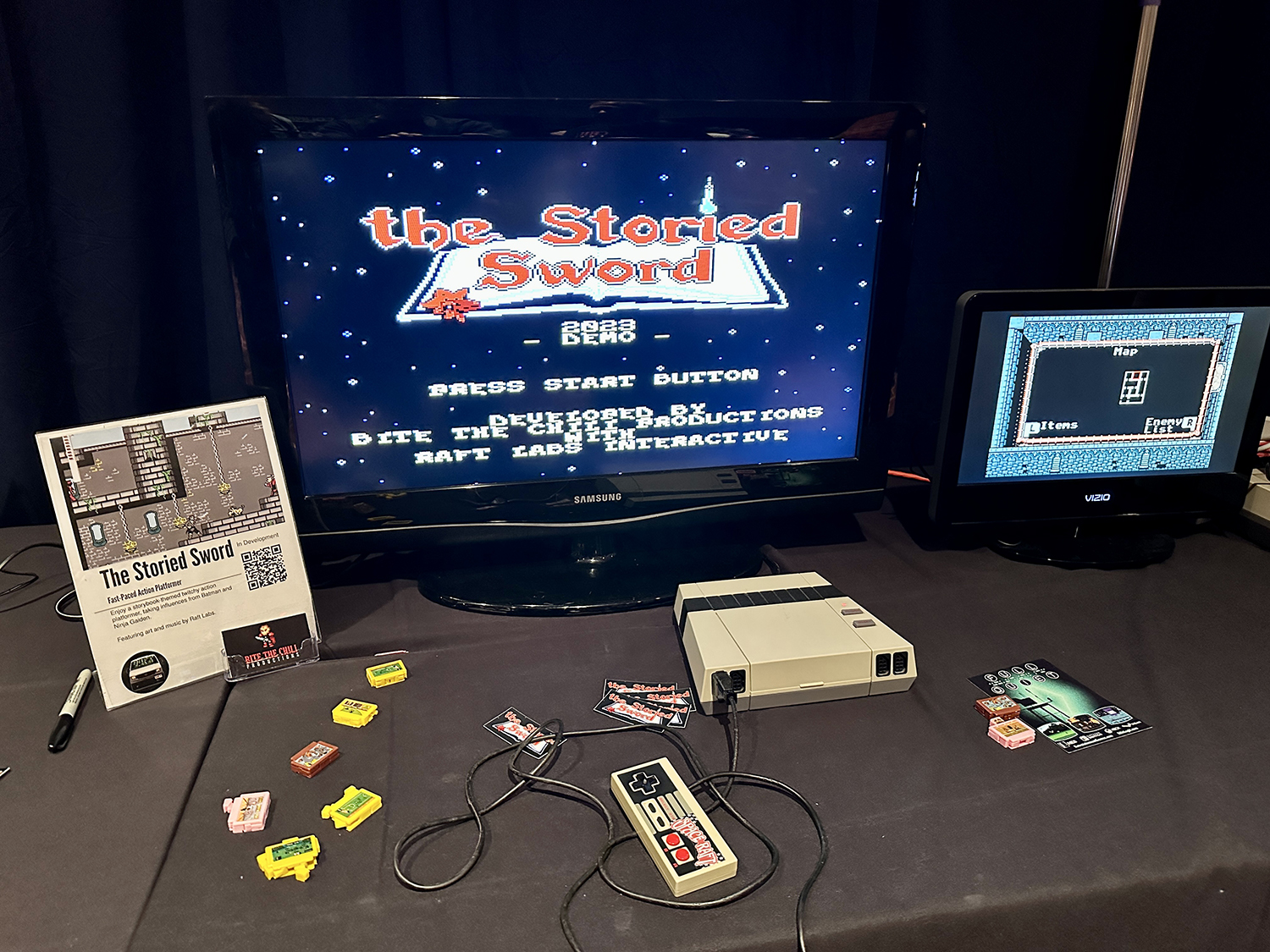Back in February, Microsoft announced that its state-of-the-art (and pricey) PlayStation 5 was entering “the latter stage of its life cycle.” This came as something of a shock for PS5 owners, since the console was barely three years old. Compare that to the life cycle of the Nintendo Entertainment System. Thanks to an international and ever-expanding “homebrew” community, the 40-year-old system is as popular as ever.
In Milwaukee, that buzzing homebrew scene boasts a homegrown star: musician-turned-game-designer Jordan Davis—a.k.a. Raftronaut. In 2020, Davis released the delightful Space Raft: The Game, a “rock ‘n’ roll retro-game experience” that featured Davis’ band, its music, and oodles of Milwaukee locations and characters ported over to the 8-bit world.
Now, Davis has lent his pixel art and chiptune talents to The Storied Sword, a “wall jumping, sword slinging, swashbuckling platforming adventure” for the NES. Co-developed by Illinois-based designer Nathan Tolbert—and featuring illustration work by Milwaukee’s Steven Deau, and color work by Arella Warren—the game is a wickedly fun and challenging love letter to retro classics like Ninja Gaiden and Batman: The Video Game. It’s all shot through with a charming fantasy adventure story that takes its cues from The Princess Bride and Zorro. That combination clearly has an audience, too: a Kickstarter to produce physical copies of the game surpassed its $10,000 goal in less than 24 hours.
Ahead of this weekend’s Midwest Gaming Classic—where Davis will be showing off a playable build of The Storied Sword—Milwaukee Record chatted with the busy game designer about making music for the NES, making pixel art for the NES, and the state of the homebrew scene. (This conversation has been edited for length.)
Milwaukee Record: It’s been four years since you released Space Raft: The Game. Other than The Storied Sword, what have you been up to?
Jordan Davis: This is probably the busiest period of my life since releasing Space Raft. My friend convinced me to go to MATC to take some programming courses, and that’s basically what my pursuit has been for the last three years. Right after Space Raft was released, X-Ray Arcade contacted me to do the arcade version of that game. It’s basically a complete overhaul. It’s not a sequel, but I like to call it a remix. I’ve also done about 30 soundtracks that I’ve written for the NES in the past four years. People contact me to write music, and I’m really efficient at it. I made Space Raft as a way to showcase my ability in NES audio, and therefore I got a lot of offers to compose music for games. I’ve done a lot of projects for friends, and I’ve had 12, 13, or 14 major releases on cartridges. A lot of them are just little game jams or competition entries, something we did over a weekend. But anytime there’s a game that requires writing four or five songs—you know, title music, gameplay music, high score music, player death music—I feel like I’ve gotten pretty good at nailing that down.
MR: With Space Raft you were adapting existing songs—your own songs. But now you’re composing completely original tunes. Is that harder to do?
JD: It’s actually much easier! When I was working on Space Raft it was a little frustrating being stuck inside the box of the music. Space Raft the band is four musicians, and three of them are also singers. There are a lot of layers to figure out, and how to adapt that down to what the NES is capable of. So to write original music, I would design it to sound good to start with. The music for Space Raft took me a long time. It was something I worked on for months, constantly refining it so that the sound effects would sound better, and have a better performance throughout testing. All those lessons built up into a working knowledge of how to get something to work the first time.
MR: Let’s talk about The Storied Sword. Where did it come from? How did you connect with Nathan?
JD: Nathan was actually the first person I met in the NES development scene. I had been following an artist in Sweden called FrankenGraphics. She has a blog that has all the pixel art work she does, and she does amazing stuff. I got really inspired by looking at her artwork and then went to the Midwest Gaming Classic in 2019. I walked into the NES homebrew room and immediately saw her pixel art on one of the screens for a game that she was working on called Halcyon. It turned out that Nathan was the programmer on that project, and he was standing in the room next to Halcyon showing it off. So I just walked up and introduced myself. I hadn’t really established myself as a developer, because this was before Space Raft had been released.
Afterwards, when Space Raft was released, Nathan recognized that I was doing art work and pixel art. Knowing that his other projects were taking a long time in development, he wanted to start a new medium-sized project with some platforming mechanics and a loose of fantasy aesthetic on top of it. And from there, we just kind of built it out. I asked if I could do the music as well. It’s really only my second or third graphics project. It was a big challenge for me to reinvent my skills for a new kind of perspective.
MR: This kind of 8-bit character design seems really difficult, trying to bring characters to life using a limited number of pixels. I imagine you spent a ton of time on it for The Storied Sword.
JD: Absolutely. Ironically, as much as a dyed-in-the-wool musician I am, this process has shown me that doing animation and pixel art is my first passion. I really love learning and getting better at it. Whenever I animate something and I feel good about it, it’s an incredibly rewarding feeling.
I started this project feeling very intimidated, so I figured I would do my due diligence and start with research. I dissected a bunch of graphics from source material like Ninja Gaiden and Batman. But I also dug deep into other platformers. The NES library is pretty rich with action platformers. Kabuki: Quantum Fighter, Shatterhand, and Shadow Of The Ninja were really big inspirations, and even earlier examples like Rush’n Attack. I dissected some of those things, like how a larger character runs convincingly. I looked a lot at Prince Of Persia to see if there was something I could glean from that. I tried some early examples with 2.5-D, where the walls have some dimension like they do in the first Ninja Gaiden. I ended up scrapping that because it’s a lot harder to animate that and to store it all in memory. It’s complicated, but the way that the colors work, the NES makes it harder to color stuff like that.

Once that was finished, and the template for a lot of the animation was done, we were only planning on doing one character. But because we were doing a Princess Bride trope in our first level, I drew what the equivalent princess would be like. I kind of had a moment: I raised my stepdaughter and realized that perpetuating another Pauline-like trope from Donkey Kong—a helpless princess in video games—was a really demeaning trope for women, and it’s not something I wanted to perpetuate. So looking at my princess in distress character, I drew a sword on her. And then I immediately thought, well, we should just have two playable characters, and I’ll animate her as well. And since the heavy lifting was already done, I felt like I was able to run with her and create her out of my own imagination.

MR: How helpful is something like the Midwest Gaming Classic to the homebrew scene? I imagine it’s a place where people in the community can finally meet face-to-face in the same room.
JD: For the community part, it’s amazingly helpful. Because of the way the Midwest Gaming Classic is structured, and because of the low-pressure atmosphere, it’s become one of the best hangouts for homebrew developers, specifically for the NES. Portland has a really good Atari dev scene, and MAGFest out in the DC area has a really good chiptune, Genesis, and SNES scene. But the Midwest Gaming Classic, at least in our homebrew area, is almost exclusively NES homebrew. Last year we had developers from three different countries. Altogether we had like 25 or 26 people. It was a really massive event.
MR: And what about the overall state of the homebrew scene? When I saw you at last year’s MGC, someone was showing off an officially licensed Garbage Pail Kids game for the NES. It seems like homebrew has gone relatively mainstream.
JD: I would legitimately call it a cottage industry at this point. There’s a licensed Rugrats game for the NES on Limited Run Games. There’s a Kevin Smith / Jay and Silent Bob game that’s based on Mallrats, which is a very high-level, exceptional game. So yeah, there’s a bit of an argument going on internally in the community if it’s even homebrew anymore. There are a lot of legitimate game devs making stuff for the NES now. There’s been a lot of high-profile releases, which creates arguments for distinctions of what is and what is not homebrew.
From my perspective, I came to NES homebrew from the punk rock community here in Wisconsin. My contribution to it is community organizing stuff, which is pretty natural for people who have done show organizing and organized scenes before. It’s grown a lot in the last few years. Just last year alone, looking at the two dozen people at MGC who had made several NES games, it was a real eye opener. It’s a vibrant community.

Midwest Gaming Classic, 2023
Want more Milwaukee Record? Subscribe to our free weekly newsletter and/or support us on Patreon.
RELATED ARTICLES
• Now Milwaukee music is playing with power in the delightfully retro ‘Space Raft: The Game’
• Our bodies are ready: Midwest Gaming Classic returns to Baird Center April 5-7
• My Saturday at the 2023 Midwest Gaming Classic: A minute-by-minute report

